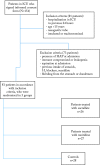STRESS ULCER PROPHYLAXIS AS A RISK FACTOR FOR TRACHEAL COLONIZATION AND HOSPITAL-ACQUIRED PNEUMONIA IN INTENSIVE CARE PATIENTS: IMPACT ON LATENCY TIME FOR PNEUMONIA
- PMID: 31363328
- PMCID: PMC6629202
- DOI: 10.20471/acc.2019.58.01.10
STRESS ULCER PROPHYLAXIS AS A RISK FACTOR FOR TRACHEAL COLONIZATION AND HOSPITAL-ACQUIRED PNEUMONIA IN INTENSIVE CARE PATIENTS: IMPACT ON LATENCY TIME FOR PNEUMONIA
Abstract
Stress ulcer prophylaxis is associated with bacterial colonization of respiratory tract. The aims of our study were to determine risk factors for trachea colonization (TC), colonization of pharynx (CP) or stomach (CD) and hospital-acquired pneumonia (HAP), and divide the factors into those with high risk and low risk. The study population (ventilated intensive care unit (ICU) patients eligible to receive stress ulcer prophylaxis) was randomized to receive one of three different treatment protocols: ranitidine, sucralfate, and no stress ulcer prophylaxis (control group). Clinical data relative to pre-specified risk factors for TC or HAP were recorded, as follows: APACHE II score (second risk factor), duration of intubation or tracheotomy (third risk factor), duration of mechanical ventilation (fourth risk factor) and duration of hospitalization in the ICU (fifth risk factor). Gastric pH was recorded and microbiological data regarding stomach, pharynx and trachea were collected on the 1st, 2nd, 3rd and 5th day. Fifty-eight out of 81 patients developed HAP (including ventilator-associated pneumonia), which occurred later in patients with gastric content pH <4 or those that were tracheotomized. Stress ulcer prophylaxis was not associated with HAP; however, it was proved as a risk factor for TC. TC was detected in tracheotomized patients and was caused by gram-negative pathogens. CP was associated with TC, since the majority of patients had CP before TC. A combination of risk factors (APACHE II >18, age >65, mechanical ventilation and sedation) caused a higher incidence of HAP and lower incidence of TC. HAP was more frequent in patients staying in the ICU for >10 days and those with cardiovascular disease as the underlying disorder. Sedation and previous antibiotic therapy correlated with longer latent period (LAT), while higher values of gastric content pH were related to shorter LAT. The longest LAT was found in patients colonized with Acinetobacter spp. Risk factors that accelerated the occurrence of HAP were found to have caused previous colonization. A combination of risk factors increased the likelihood of TC and HAP, and shortened LAT between TC and HAP.
Keywords: Bacteria – growth and development; Healthcare-associated pneumonia; Intensive care units; Peptic ulcer; Risk factors; Tracheostomy.
Figures





Similar articles
-
The role of intragastric acidity and stress ulcus prophylaxis on colonization and infection in mechanically ventilated ICU patients. A stratified, randomized, double-blind study of sucralfate versus antacids.Am J Respir Crit Care Med. 1995 Dec;152(6 Pt 1):1825-34. doi: 10.1164/ajrccm.152.6.8520743. Am J Respir Crit Care Med. 1995. PMID: 8520743 Clinical Trial.
-
Nosocomial pneumonia in mechanically ventilated patients receiving antacid, ranitidine, or sucralfate as prophylaxis for stress ulcer. A randomized controlled trial.Ann Intern Med. 1994 Apr 15;120(8):653-62. doi: 10.7326/0003-4819-120-8-199404150-00005. Ann Intern Med. 1994. PMID: 8135449 Clinical Trial.
-
A comparison of the frequency of stress ulceration and secondary pneumonia in sucralfate- or ranitidine-treated intensive care unit patients.Crit Care Med. 1991 Dec;19(12):1491-6. doi: 10.1097/00003246-199112000-00009. Crit Care Med. 1991. PMID: 1959368 Clinical Trial.
-
[Prevention of stress ulcer and pneumonia: sucralfate].Klin Wochenschr. 1991;69 Suppl 27:12-5. Klin Wochenschr. 1991. PMID: 1809814 Review. German.
-
Current guidelines on stress ulcer prophylaxis.Drugs. 1997 Oct;54(4):581-96. doi: 10.2165/00003495-199754040-00005. Drugs. 1997. PMID: 9339962 Review.
Cited by
-
The Japanese Clinical Practice Guidelines for Management of Sepsis and Septic Shock 2024.J Intensive Care. 2025 Mar 14;13(1):15. doi: 10.1186/s40560-025-00776-0. J Intensive Care. 2025. PMID: 40087807 Free PMC article.
-
Pharmacological interventions for preventing upper gastrointestinal bleeding in people admitted to intensive care units: a network meta-analysis.BMJ Evid Based Med. 2025 Jan 22;30(1):22-35. doi: 10.1136/bmjebm-2024-112886. BMJ Evid Based Med. 2025. PMID: 38997152 Free PMC article.
-
Efficacy and safety of gastrointestinal bleeding prophylaxis in critically ill patients: an updated systematic review and network meta-analysis of randomized trials.Intensive Care Med. 2020 Nov;46(11):1987-2000. doi: 10.1007/s00134-020-06209-w. Epub 2020 Aug 24. Intensive Care Med. 2020. PMID: 32833040
-
The Japanese Clinical Practice Guidelines for Management of Sepsis and Septic Shock 2024.Acute Med Surg. 2025 Feb 24;12(1):e70037. doi: 10.1002/ams2.70037. eCollection 2025 Jan-Dec. Acute Med Surg. 2025. PMID: 39996161 Free PMC article.
-
HIGH-FLOW NASAL CANNULA COMBINED WITH PRONE POSITIONING AS AN INTUBATION ALTERNATIVE IN COVID-19: A CASE REPORT AND REVIEW OF THE LITERATURE.Acta Clin Croat. 2022 Dec;61(4):707-710. doi: 10.20471/acc.2022.61.04.18. Acta Clin Croat. 2022. PMID: 37868176 Free PMC article. Review.
References
-
- Cook D, Guyatt G, Marshall J, Leasa D, Fuller H, Hall R, et al. A comparison of sucralfate and ranitidine for the prevention of upper gastrointestinal bleeding in patients requiring mechanical ventilation. Canadian Critical Care Trials Group. N Engl J Med. 1998;338(12):791–7. 10.1056/NEJM199803193381203 - DOI - PubMed
-
- Prod’hom G, Leuenberger P, Koerfer J, Blum A, Chiolero R, Schaller MD, et al. Nosocomial pneumonia in mechanically ventilated patients receiving antacid, ranitidine, or sucralfate as prophylaxis for stress ulcer. A randomized controlled trial. Ann Intern Med. 1994;120(8):653–62. 10.7326/0003-4819-120-8-199404150-00005 - DOI - PubMed
Publication types
MeSH terms
Substances
LinkOut - more resources
Full Text Sources
Medical
Research Materials
Miscellaneous
